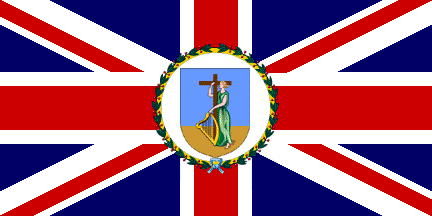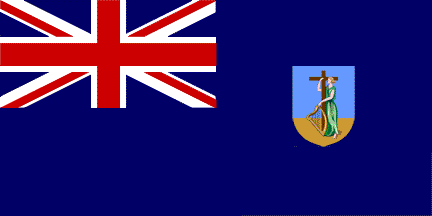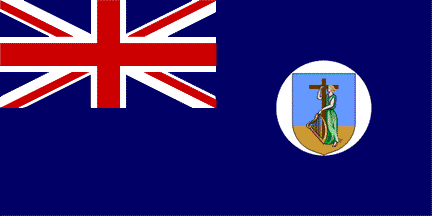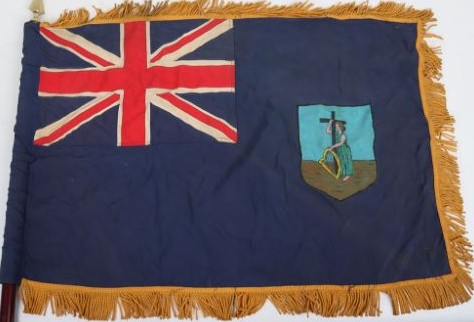![[Montserrat]](../images/m/ms.gif) image
by Martin Grieve, 28 January 2004
image
by Martin Grieve, 28 January 2004
Last modified: 2025-04-12 by rob raeside
Keywords: montserrat | america | harp | cross | passion | woman | ireland |
Links: FOTW homepage |
search |
disclaimer and copyright |
write us |
mirrors
![[Montserrat]](../images/m/ms.gif) image
by Martin Grieve, 28 January 2004
image
by Martin Grieve, 28 January 2004
Official Name: Montserrat
Flag adopted: 25
January 1999 (Originaly adopted: 10 April 1909)
Coat of Arms adopted: 25 January 1999
See also:
The arms show a woman with a harp, embracing a passion cross.
James Dignan, 27 November 1995
I have been looking through some books, and as might be
expected: all books have slightly different images. That is: from
c. 1960 on. It doesn't appear in Kannik (c.1959) and in the
Observer Book of flags (1959) - no badge reported either.
I just went browsing - about the same result: some 5 pages with a
flag of Montserrat, all a little bit different, but one thing in
common: no disk! I picked two images - one from
members.aol.com/montsiac/monthome.htm (defunct), where it
looks like a logo - (to view - click
here) - and a curious one from the Montserrat
Government page (to view - click
here) - the CoA looks way too big. Same image on the Commonwealth
Games page, My question of course: has there been a flag
change in Montserrat? .
Jarig Bakker, 30 January 2000
In the late Wm. Compton's book "The Complete Guide to
Flags (1989) [cra89] , the badge
in the field has different colors than the larger badge shown to
show detail. Both versions are on a white disc in the usual
place.
Steve Stringfellow, 7 Febuary 2000
Shipmate flag chart (2000) shows Montserrat blue ensign with
badge in white disc meanwhile here and in Flag Database (by FI)
have blue ensign without white disc. Which one is correct ?
Nozomi Kariyasu, 17 June 2000
In 1999 the Ministry of Defence (MoD) department in charge of
flags, the DCTA, decided, in consultation with the College of
Arms, that the badges on many British flags were too small for
identification. They also did not match the newer flags granted
directly by the Queen, through the College of Arms, which have
much larger badges.
So the MoD decided to make the badges much larger - the size and
placement of badges on British ensigns was a decision in the
power of the Admiralty, and passed to the MoD when the Admiralty
ceased to exists as a separate body. So the MoD was simply
exercising its authority in the matter, for the better
identification of flags.
This meant that the white discs had to get larger. In fact the
discs had to be so large that they looked ridiculous and it was
therefore decided to discard them as they were no longer
necessary, the new badges being clear even without the discs. So
the new illustration of the Falkland Islands,
Cayman Islands and Montserrat in BR20 (the
government flag book) all had much larger badges (but no change
to the design of the badge) and no white discs.
Of course the MoD's authority on flags only covers flags at sea,
so the Islands concerned are free to continue using flags with
discs on land if they wish to, but flags for use at sea should no
longer have discs (unless they are old flags still in use). The
question of discs of red ensigns is more complex as the size and
placement of badges is usually specified in the Statutory
Instrument that creates them and it is not clear whether the long
standing MoD/Admiralty power over the size and placement of
badges can be used to alter a flag created by a Statutory
Instrument.
Graham Bartram, 6 July 2000
Original flag adopted 10 April 1909. Current flag adopted 25
January 1999.
Nozomi Kariyasu, 10 January 2002
The badge was enlarged in 1999 for use on a Blue Ensign. The
badge is also fimbriated white so as not to blend with the dark
blue field. I am not aware of any "official" figures
describing the badge height/hoist width ratio, so I have guessed
approximately 1/2.
Martin Grieve, 28 January 2004
Graham Bartram's illustration of this flag in BR20 (which is
the nearest we have to 'official specs') actually shows the
fimbriated shield at 54% of flag width.
Christopher Southworth, 28 January 2004
As a British Overseas Territory in the Caribbean, its color specifications
follow British practice
Other sources for colors:
The Olympic Flag
Manuals are not relevant in case of Montserrat, because it is not member of IOC.
The French Navy Books illustrate the flag of Montserrat, and the governorís
flag, but donít give any color specification.
Vexilla Mundi gives colors in Pantone
system: PMS 281C (blue), 186C (red), and PMS White.
Wikipedia illustrates the flag, but
doesnít give color specification.
Flag Color Codes gives the following
color values:
Blue: Hex: # 012169, RGB 1-33-105, CMYK 99-69-0-59, Pantone
280C, RAL 5026
White: Hex. # FFFFFF, RGB 255-255-255, CMYK 0-0-0-0,
Pantone N/A, RAL N/A
Red: Hex: # C8102E, RGB 200-16-46, CMYK 0-92-77-22,
Pantone 186C, RAL 3028
Zoltan Horvath, 18 July 2024
Željko asked about the flag of Montserrat, how a
British dependent territory with such a French sounding name ends
up with Irish symbols.
Welcome to the Caribbean, where the various islands changed hands
between Spain, England, France, Holland, and others countless
times. It can make for some very confusing symbology; as it turns
out, Montserrat comes by its flag quite legitimately.
It was named by that Italian fellow sailing for Spain, Colombus,
in 1493, after an abbey -- one not in France but in Spain. This
abbey was supposedly where Ignacio de Loyola experienced the
vision which led to the formation of the Jesuit monastic order.
It was eventually settled (the island, not the abbey) by Thomas
Warner, a Briton, who brought English and Irish Catholics from
St. Kitts, and the island soon gained a reputation as a Caribbean
safe haven for Catholics, particularly those fleeing from
Virginia (which is extremely odd, considering that Maryland, the
only American colony with religious tolerance, was right next
door...but that's Virginians for you).
Cromwell also sent Irish political prisoners to Montserrat
following his victory at Drogheda in 1649. The first African
slaves, bought by an Irishman, landed in 1651, and there was a
slave revolt in 1768.
The French raided several times during the 17th and 18th
Centuries, sometimes aided by the resident Irish, but the island
became British for good with the Treaty of Versailles in 1783.
BTW, Montserrat was the island hardest-hit by Hurricane Hugo in
1989.
The source (Caribbean Islands Handbook 1991, Prentice Hall, B.
Box and S. Cameron, eds.) further states:
"The Irish influence can still be seen in national emblems -- on arrival your passport is stamped with a green shamrock, the island's flag and crest show a woman, Erin of Irish legend, complete with her harp, and a carved shamrock adorns the gable of Government House."
Steve Kramer, 26 May 1996
In 1997 the Soufriere Hills volcano erupted and the
nine-tenths of the island's population was evacuated.
Rob Raeside
 image
by Martin Grieve, 28 January 2004
image
by Martin Grieve, 28 January 2004
.gif) image
by Martin Grieve, 28 January 2004
image
by Martin Grieve, 28 January 2004
I received a scan from David Prothero of the shield of
Montserrat, which shows Erin (the female figure - symbol of
freedom for Ireland) holding a gold, or deep yellow harp by her
left hand. The colouring of this harp in the original scan is
brown, matching the foreground upon which she stands. On the
original image there is also a shadow behind her left foot, which
I decided to retain in my image.
Martin Grieve, 28 January 2004
From Geography of the West Indies" by J.O.Cutteridge:
"A peculiarity of Montserrat is that the inhabitants speak
with a decided Irish brogue, a circumstance traceable to the fact
that a large number of Irish were sent out to the island by
Oliver Cromwell in the 17th century. Place names such as
Kinsale and Harris Village owe their origin to these early Irish
settlers."
David Prothero, 30 January 2004
In 1909 when the arms were designed (by a Mrs Goodwin) all of
Ireland was, as we know, part of the United Kingdom, and they
were meant to recall that Montserrat was settled by Irish
immigrants in 1632.
Christopher Southworth, 30 January 2004
 image
by Martin Grieve, 28 January 2004
image
by Martin Grieve, 28 January 2004
 image
by Martin Grieve, 28 January 2004
image
by Martin Grieve, 28 January 2004
The badge was adopted in 1906, whereas the flag only much
later, officially in 1960. One version has the badge directly
on the Blue Ensign occupying an imaginary circle, the
diameter being 4/9 the hoist width. A variant may or may not have
been extant, and this version shows the badge on a white circle.
Both the versions with white disc and without have been reported,
but it is not clear which is correct.
Martin Grieve, 28 January 2004
 image
located by William Garrison, 18 March 2025
image
located by William Garrison, 18 March 2025
An example of the Montserrat national flag, with smaller shield and no white
border around shield, multi-piece construction, double-sided flag with yellow
fringe, 57 x 84 cm.
William Garrison, 18 March 2025
Montserrat is divided to 3 parishes. There are no known flags
of those parishes. The parishes are:
- Saint Anthony
- Saint Peter
- Saint Georges
List based on Administrative
divisions of the World.
Dov Gutterman, 25 October 2004